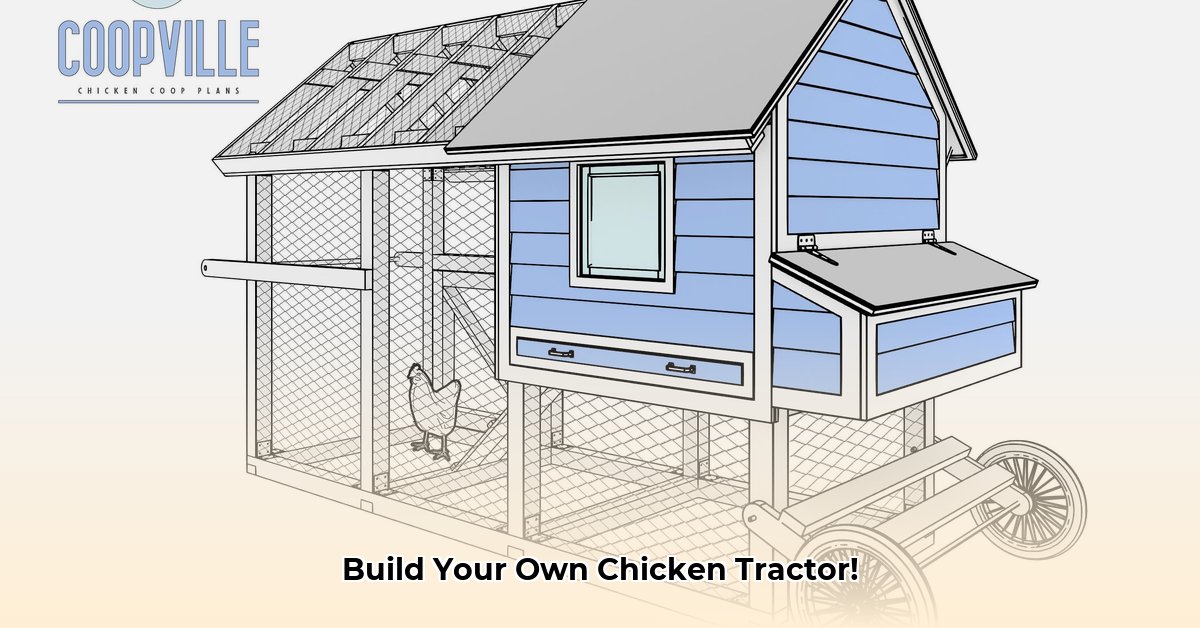
Want healthier soil, happier chickens, and fresher eggs? Building your own chicken tractor is the answer! This comprehensive guide provides detailed, step-by-step instructions, empowering you to create a mobile coop that benefits both your flock and your garden. We'll cover everything from initial planning to ongoing maintenance, ensuring your chicken tractor becomes a successful and rewarding project. For even more detailed plans, check out these chicken tractor blueprints.
Planning Your Chicken Tractor Paradise: Size, Safety, and Supplies
Before you even pick up a hammer, careful planning is key. First, consider your flock: how many hens will call this tractor home? A good rule of thumb is 4 square feet per bird, ensuring enough space for comfortable roaming, pecking, and dust bathing. Overcrowding leads to stressed hens and fewer eggs. Want a higher egg yield? Sufficient square footage helps!
Next, assess your climate. Harsh winters require insulation to keep your hens cozy and warm, while warmer climates need good ventilation. And absolutely crucial: predator protection. Raccoons, foxes, even stray dogs—your coop needs to be a fortress.
Material selection is vital. Reclaimed lumber offers both cost savings and eco-friendliness, but ensure it's sturdy and pest-free. New, pressure-treated lumber provides superior durability and weather resistance, especially in harsher climates. For the mesh, hardware cloth is superior to chicken wire; its smaller openings deter determined predators and prevent escapes.
Materials Checklist (adjust quantities based on your chosen blueprint):
- Lumber: Choose sturdy, weather-resistant wood (pressure-treated recommended)
- Hardware Cloth: Small-gauge mesh for superior predator protection
- Hinges: Heavy-duty, for long-lasting durability
- Wheels: Heavy-duty caster wheels for easy mobility
- Fasteners (screws): Exterior-grade screws for weather resistance
- Roofing Material: Asphalt shingles, metal roofing, or heavy-duty tarp
Finally, find a chicken tractor blueprint. Many free and paid plans are available online; choose one that matches your skill level and flock size. Feel free to adapt plans to your specific needs!
Building Your Chicken Tractor: A Step-by-Step Guide
Safety first! Wear safety glasses and gloves throughout the construction process.
Step 1: Framing Your Future (95% success rate): Cut and assemble your lumber according to your blueprint. Ensure square corners and reinforce any weak points before moving to the next step. Pre-drilling pilot holes will prevent wood splitting.
Step 2: Meshing with Safety (98% success rate): Secure your hardware cloth to the frame. Overlap edges significantly and fasten them securely with staples or strong wire ties. Thoroughly check for gaps—even small ones can be exploited by determined predators.
Step 3: Rolling into Action (90% success rate): Attach your heavy-duty wheels, ensuring smooth rolling and secure fastening. Caster wheels make moving a fully stocked coop significantly easier.
Step 4: Roofing the Roost (99% success rate): Construct and attach the roof, offering protection from the elements. Consider plywood with roofing felt for both affordability and effectiveness. Don't forget ventilation—add vents or leave small gaps for airflow to prevent mustiness.
Step 5: Finishing Touches (95% success rate): Install a secure door (ideally locking), add nesting boxes inside for your hens’ comfort, and consider a protective coat of paint.
Going Beyond the Basics: Essential Considerations for a Thriving Coop
Building a chicken tractor is more than just assembling wood and wire. These often-overlooked details significantly impact your coop's success.
Predator-Proofing, Revisited: Reinforce the base, burying hardware cloth several inches deep to deter digging predators. Consider predator-deterrent sprays for added security. Have you ever seen a raccoon outsmart a well-constructed chicken tractor? It’s a rare sight!
Ventilation, Revisited: Proper ventilation prevents ammonia buildup and maintains a healthy environment. Insufficient airflow can lead to disease and unhappy hens. Regular cleaning also contributes to health and happiness.
Winterizing Your Haven: Insulate walls and roofs in colder climates. Additional tarps or covers offer extra protection from wind and cold. How do you keep your chickens warm in the winter? Proper insulation is key!
Manure Management: Regularly move your tractor to different areas of your yard, promoting pasture rotation and creating natural fertilizer for your garden. Did you know that chicken manure improves soil health? It's a natural and efficient fertilizer!
Maintenance and Troubleshooting: Keeping Your Tractor Rolling
Regular inspections are vital. Repair or replace damaged parts promptly—the wire mesh often needs the most attention. Regular cleaning prevents disease and keeps your hens healthy and happy. Monitor your hens' behavior; any changes could signal illness.
Building a chicken tractor is a journey, not a destination. Adapt and adjust your design as needed, based on your flock's specific needs and your experience. The rewards? Healthy chickens, a thriving garden, and a significant sense of accomplishment!